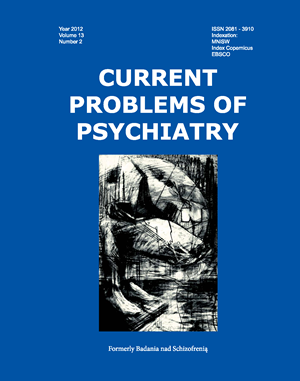Assessment of chosen elements of physical quality of life in patients treated due to type 2 diabetes
Keywords:
quality of life, diabetes mellitus, oral diabetes treatment, insulin therapyAbstract
Introduction. Diabetes is a persistent disease, leading to many complications, in which it is possible to assess subjective sense of the quality of life in patients. In medicine, the quality of life is defined in the context of health condition (HRQOL health-related quality of life). Medical decisions, made at various levels of treatment, come down to common aim, which is optimum employment of available resources to provide the best health conditions in patients, to whom the decisions apply. However, not all aspects of health can be subsumed in such parameters, hence while choosing treatment method, the results of clinical tests, one’s own experience, and expectations of the patient should be taken into account. On the basis of systematic and many-sided assessment of the quality of life of the patients suffering from diabetes, treasure trove can be acquired about the deficit in the area of patient’s functioning, in which it is necessary to implement changes.
The aim of the study. The aim of the paper is to assess the influence of diabetes therapy on elements of the quality of life of the patients treated because of type 2 diabetes.
The research and the method. A group of 77 patients with type 2 diabetes, treated in Outpatients Clinics in Lublin, were examined. Research tool was the self-made questionnaire, evaluating certain elements of psychic quality of life of the patient.
Results and Conclusions. Subjective sense of psychic quality of life of diabetes patients depends on the therapy type. Patients treated with oral medications are better in coping with difficulties of everyday life. People suffering from diabetes should be under permanent psychological treatment which aim would be to i.e., improve their quality of life by professional support.
References
1. Wild S., Roglic G., Green A., Sicree R., King H. Global prevalence of diabetes: estimates for the year 2000 and projections for 2030. Diabetes Care, 2004; 27(5): 1047-1053.
2. Fritschi C., Quinn L. Fatigue in patients with diabetes: a review J Psychosom Res, 2010; 69(1): 33-41
3. Kong D., Ding Y., Zuo X., Su W., Xiu L., Lin M., Rao S., Yu S. Adaptation of the Audit of Diabetes-Dependent Quality of Life questionnaire to people with diabetes in China. Diabetes Res Clin Pract, 2011 94(1): 45-52.
4. Zdrojewski T., Szpakowski P., Bandosz P., Pajk A., Wicek A., Krupa-Wojciechowska B. Wyrzykowski B. Arterial hypertension in Poland in 2002. J Hum Hypertens, 2004; 18: 557-562.
5. Sieradzki J., Wilkins A., Szczepański M. SCREEN-POL 2 – aktywne wyszukiwanie i wczesne rozpoznawanie cukrzycy typu 2 u pacjentów zgłaszających się do lekarzy podstawowej opieki zdrowotnej w Polsce. Wyniki ogólnopolskiego, wieloośrodkowego programu przesiewowego. Diabetol Prakt, 2005; 6(3): 103-114.
6. International Diabetes Federation: Diabetes Atlas. Third Edition, Brussels, 2006, 1-378.
7. Chrobak M. Ocena jakości życia zależna od stanu zdrowia. Probl Pielęg, 2009; 17(2): 123-127.
8. Pszczołowski T. Mała encyklopedia proksologii i teorii organizacji. Wrocław; Ossolineum: 1978: 92.
9. Dziurowicz-Kozłowska A. Wokół pojęcia jakości życia. Psychologia jakości życia, 2002; 1(2): 77-100.
10. Lewko J., Krajewska-Kułak E. Wielowymiarowa ocena jakości życia chorych na cukrzycę. Pol Merk Lek, 2010; 28(168): 486-489.
11. Tobiasz-Adamczyk B. Wybrane elementy zdrowia i choroby. Kraków; Wydawnictwo Uniwersytetu Jagiellońskiego: 2000: 233-251.
12. Pietrzykowska E., Zozulińska D., Wierusz-Wysocka B. Jakość życia chorych na cukrzycę. Pol Merk Lek, 2007; 23(136): 311-314.
13. Czechura J. Terapia ciągłym podskórnym wlewem insuliny z zastosowaniem pomp insulinowych a jakość życia pacjentów. Przegląd Medyczny Uniwersytetu Rzeszowskiego i Narodowego Instytutu Leków w Warszawie, 2010; 4: 435-443.
14. Krans H.M.J., Porta M., Kenn H. Staehr Johanson K. Diabetes care and research in Europe. The St. Vincent Declaration action programme: implementation document (WHO). Giorn Ital Diabetol, 1995; 10: 40-45.
15. Kovacs M., Goldston D., Obrosky D.S., Bonar L.K. Psychiatric disorder in youths with IDDM: rates and risk factors. Diabet Care, 1997; 20(1): 36-44.
16. Rubbin R.R., Peyrot M. Quality of life and diabetes. Diabet Metab Res Rev, 1999: 15: 205-218.
17. Dzieciuchowicz Ł., Pawlus M., Brzeziński J., Cerkaska K. Ocena wybranych elementów jakości życia u chorych leczonych z powodu stopy cukrzycowej. Now Lek, 2002; 71(6): 287-291.
18. Charońska E., Janus B., Promocja zdrowia i edukacja zdrowotna. Pielęgniarstwo 2000; 99: 19-25.
19. Korzon-Burakowska A., Adamska K., Skuratowicz-Kubica A., Jaworska M., Świerblewska E., Kunica K. Wpływ edukacji na parametry wyrównania cukrzycy i jakość życia chorych na cukrzycę typu 2 leczonych insuliną. Diabetol Prakt 2010: 11(2): 46-51.


